Photonics
Plasmonic nanoantenna based triggered single-photon source
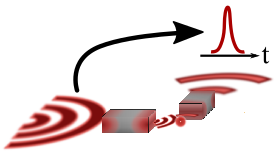
We have already discussed the generation of single photons by nanoantennas at high rates before.
However, single-photon generation is a statistical process and for industrial applications it is often needed that
the generation of single photons is known up to a timeframe of a few nanoseconds only.
Here we present a solution to this drawback: triggered single-photon generation.
We use a hybrid plasmonic device consisting of a lambda-type quantum emitter and a nanoantenna and develop a descriptive theory for it.
In this theory, the dynamics of the hybrid system is mathematically hugely simplified. It can be used to design real-world devices.
As a proof-of-principle, an examplary design is shown to adhere to the demanding requirements of triggered single-photon sources with extremely high output from a nanoscopic volume.
Efficient mode conversion in an optical nanoantenna mediated by quantum emitters
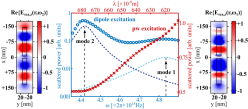
Information technology requires the conversion of optical signals from one energy to another.
We present a way how this can be achieved using state-of-the-art nanotechnology.
Slightly asymmetric optical nanoantennas exhibit different modes with a certain spatial overlap.
With the help of a quantum emitter, the coupling between these modes can be efficiently mediated.
The quantum emitter thereby acts as an energy shifter due to its internal level structure:
It takes energy out of a high-energy mode, converts it to slightly less energy which in turn excites another mode of the nanoantenna.
Because of the increased coupling between the nanoantenna modes and the quantum dot ones, this process is extremely fast and very efficient.
Our approach is therefore suitable for fast and efficient next generation signal conversion.
Fluorescence enhancement in large-scale self-assembled gold nanoparticle double arrays
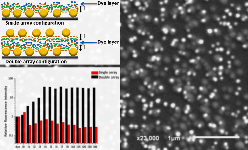
Closely spaced nanoparticles like dimers allow the localization of electromagnetic fields to tiny volumes. When quantum emitters, such as dyes, are placed in the gap of those dimers, their absorption and emission characteristics can be modified. Both processes have to be considered when aiming to enhance the fluorescence from the quantum emitters. This is particularly challenging for dimers, since the electromagnetic properties and the enhanced fluorescence sensitively depend on the distance between the nanoparticles. Here, we use a layer-by-layer method to precisely control the distances in such systems. We consider a dye layer deposited on top of an array of gold nanoparticles or integrated into a central position of a double array of gold nanoparticles. We find a maximum of a 99-fold increase in the fluorescence intensity of the dye layer sandwiched between two gold nanoparticle arrays. Our work paves the way for large-scale, high throughput, and low-cost self-assembled functionalized plasmonic systems that can be used as efficient light sources.
Scattering Dark States in Multiresonant Concentric Plasmonic Nanorings
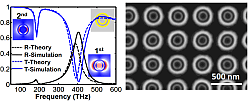
The observation of Fano resonances usually requires nanostructures with multiple plasmonic resonances like higher order multipole moments. We show that
similar spectral features can be observed with nanoantennas exhibiting solely electric
dipolar resonances.
The considered nanoantennas consist of multiple concentric gold nanorings separated by nanometric dielectric spacers. These nanoantennas exhibit multiple resonances in the visible and near-infrared. We theoretically and experimentally investigate how interference of these resonances cause Fano features
and scattering dark states.
Because of the electric dipolar character we employ a simplifed dense-array theory to predict the response of arrays of such nanoantennas from the
electric polarizability of the individual constituents with a remarkable agreement to experimental results.
A generalized Kerker condition for highly directive nanoantennas

A nanoantenna with balanced electric and magnetic dipole
moments, known as the first Kerker condition,
exhibits a directive radiation pattern with zero
backscattering. In principle, a nanoantenna can provide
significantly enhanced directionality if higher
order moments are properly balanced. We study a generalized
Kerker condition in the example of a nanoring nanoantenna
supporting electric dipole and electric
quadrupole moments. Nanoring antennas are well
suited since both multipole moments can be almost
independently tuned to meet the generalized Kerker
condition.
Nanoantennas: New Prospects in Light-Matter-Interactions (Dissertation)

The possibilities of nanoantennas for an enhanced
interaction of light with quantum systems is theoretically
investigated. A versatile framework is introduced to
describe this interaction: A classical electrodynamics
description of nanoantennas enables to freely design and
tune them for specific means. But this approach leads to a
semiclassical description of the entire system. We further
introduce a quantization scheme for nanoantennas based on
their quasinormal modes, which enables a fully quantum
treatment of the hybrid system. With this theoretical
framework at hand, different effects in the vicinity of
nanoantennas such as enhancement of dipole-forbidden
transition rates, spontaneous emission and strong coupling
are studied. A thorough appendix with all necessary
derivations is provided.
Nonlocal effects: relevance for the spontaneous emission rates of quantum emitters coupled to plasmonic structures
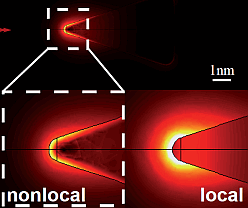
The local Drude model is a decent approximation for the
response of metal particles to electromagnetic radiation.
But for very small particles, this theory fails to predict
resonance frequencies and field enhancements. In this
publication we investigate how nonlocal effects due to the
mutual interaction of conduction electrons can drastically
alter the achievable spontaneous emission rate of truly
three-dimensional nanoparticles.
Plasmonic nanoring fabrication tuned to pitch: efficient, deterministic and large scale realization of ultra-small gaps for next generation plasmonic devices

One of the main goals of plasmonics is to derive real-world
applications from interesting research ideas. To achieve
this, a largely tunable platform is needed that allows
cost-effective, fast and large-scale fabrication. Nanorings
are such a platform granting a large range of geometric
parameters including ultra-small gaps and high aspect
ratios. Our introduced fabrication method provides a decent
platform for real-world plasmonic devices.
Nanoantennas for ultra-bright single photon sources

When nanoantennas are coupled to quantum dots, the combined
system may be used to emit single photons at extremely high
rates. The quantum dot as a fermionic system provides
single photons and the nanoantenna may enhance its emission
by orders of magnitude due to the Purcell effect. All this
can be understood withing classical electrodynamics has
been known for some time now. Yet, a fully quantum
treatment of the problem was missing to date. In such an
approach to the nanoantenna-quantum-dot-coupling we derive
an analytical expression for the emitted photon rate with
respect to the incoherent pumping rate of the quantum dot.
We find that indeed the Purcell factor is an important
figure of merit but we also find a trade-off of it with the
nonclassicality of the emitted photon rate. This result is
quite surprising and will change how we think of ultra-fast
single photon sources in general.
Strong coupling of optical nanoantennas and atomic systems
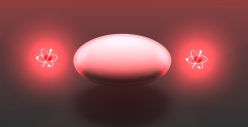
If a nanonatenna is placed very closely to a quantum
system, the so-called strong coupling regime can be
reached. In this region, the properties of the nanoantenna
and the quantum system have to be understood as a combined
system that shows rich dynamics. One of the mayor features
of such a system which may only be understood using a
rigorous quantum description, is the emergence of strong
energy shifts and entirely new energy levels. This leads to
the possiblity to taylor the properties of the combined
quantum system by design - the birth of "artificial atoms".
Enhancing the nonlinear response of plasmonic nanowire antennas by engineering their terminations
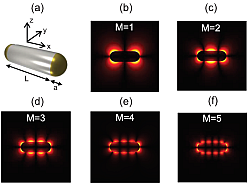
Sub-wavelength light concentration by means of plasmonic
nanoantennas is known to significantly enhance the
nonlinear response. In nonlinear schemes involving multiple
frequencies, however, it remains challenging to design
nanoantennas that respond resonantly to more than one or
eventually to all interacting frequencies. Considering
plasmonic nanowire antennas, we hereby demonstrate the
potential to engineer their resonances at more than one
frequencies involved in the nonlinear process by carefully
tailoring the antenna terminations. Although we consider
here the degenerate nonlinear process of second harmonic
generation, our approach can easily be extended to other
nonlinear processes.
Tunable Graphene Antennas for Selective Enhancement of THz-Emission
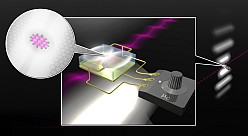
Graphene nanoantennas can be used to strongly enhance the
emission rate of quantum systems at specific frequencies in
the THz frequency band. Furthermore, the electric
properties of graphene can be tuned using the electric
field effect. We can employ the tunability of graphene
antennas to selectively enhance individual spectral
features. The selective enhancement can be extremely useful
for spectroscopy - we show for example how any weak
transition in the spectrum of coronene can become the
dominant contribution.
Controlling the Dynamics of Quantum Mechanical Systems Sustaining Dipole-Forbidden Transitions via Optical Nanoantennas
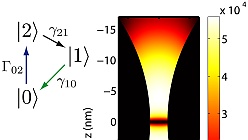
In the present of a nanoantenna, the local fields probed by
a quantum system can be dramatically different from those
of a plane wave. This can lead to the effect that
"forbidden transitions" are enhanced by several orders of
magnitude. Such an excitation leads to re-emission of
light, e.g. by luminescence. However, in the presence of
the nanoantenna, also this process is hugely affected. In
the paper we show how to control the overall process using
a certain nanoantenna and that such a fully self-consistent
treatment is necessary to understand any physical
observable.
Circular Optical Nanoantennas: An Analytical Theory
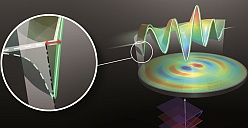
Characteristic length scales of antennas are those of the
wavelength at which they operate. For visible light, highly
sophisticated methods are needed to produce such devices,
which could be achieved just recently. Aside from the
technical problems in fabrication, there are a lot of open
questions how to theoretically treat optical antennas since
metal at optical frequencies is not a perfect conductor
anymore. Here, the light-matter interaction has to be
understood in terms of surface plasmon polaritons, a
quasiparticle formed from collective electron oscillations
coupled to an electromagnetic field. In this work, a theory
is presented to describe the physical properties of
circular optical nanoantennas made of an arbitrary stack of
discs. The theory reproduces known results for simplified
geometries and agrees very well with simulations.
Relating Localized Nanoparticle Resonances to an Associated Antenna Problem
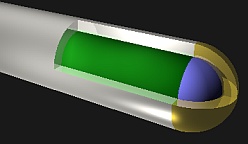
There are two main concepts to describe a resonant coupling
of a nanoparticle to an external light field. One concept
refers to eigenmodes, which has been termed
Localized Surface Plasmon Polariton (LSPP). The other
approach is to describe a dynamical situation in the sense
of a Fabry-Perot resonator -
a Propagating SPP (PSPP) gets reflected at the termination
of a nanoparticle which is resonantly excited if the phase
accumulated upon propagation and reflection adds up to
multiples of π. The given work relates these two
approaches and shows, how resonance frequencies for
arbitrarily shaped nanoparticles can be calculated and how
the characteristics of an object can be tuned by varying
its termination.
High Resolution Displacement Detection with Speckles: Accuracy Limits in Linear Displacement Speckle Metrology
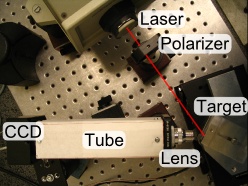
How precise can a shift of some plane interface be
measured? A speckle pattern is a tiny
feature of the reflected field from a rough surface under
coherent light illumination. Since this field is depending
on the surface variation, it has statistical properties
resulting in a highly varying unique fingerprint of a
specific area. Thus, even small movements of such a surface
can be observed. By comparing images of different surfaces
using the cross-correlation, one can
compute the displacement if the images are not taken too
far apart. Linewisely performing this procedure results in
several measurements, which can be analysed statistically
and significantly lowers the overall error. Introducing
this concept, we show how a 10nm precision on a 50µm
range is achieved.
Astrophysics and General Relativity
On the Multipole Moments of a Rigidly Rotating Fluid Body
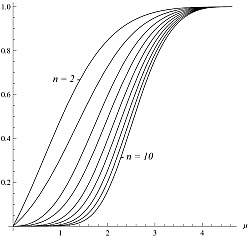
Black holes are fascinating objects. All the mass seems to be concentrated in one point and once crossing the event horizon,
anything is condemned to be added to the singularity.
Thus, black holes can be regarded as somehow extreme. The paper stresses the question, if there can be physically meaningful
spacetimes as extreme as that of rotating black holes culminating in the Generalized Quadrupole-Conjecture.
The publication sumarizes the main results of my diploma thesis
Multipolmomente axialsymmetrisch stationärer Raumzeiten
und die Quadrupol-Vermutung which tackles the introduction of multipole moments to general relativity in detail.
Stability of the Solar Tachocline with Magnetic Fields
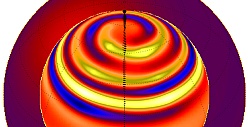
Whereas the radiative core of the sun rotates uniformly, matter in the convection zone has a complicated velocity profile
obeying differential rotation.
In between is the tachocline, a thin layer,
where a transition between these two zones takes place. Because of the fastly changing velocity profile,
strong magnetic fields arise. Performing stability analysis, the work tackles the question on the maximal strength of
magnetic fields in this region, which is crucial to understand the characteristics of
sunspots and thus solar activity.
Some more remarks concerning my research topic: plasmonic nanoantennas
Please note that the following text is solely to be a little better visible for search engines. It does not constitute a very well put-together overview of my
research or any related topic, i.e. nanoantennas, quantum systems, plasmonics etc. It is merely some more or less elaborate text to be able to put these words a little
more often into the text.
Why is this even necessary?
Depending on the density of certain words, the articles on a certain homepage get evaluated statistically. This leads to a ranking if an article is relevant to a topic or not.
So, if a word appears quite frequently in the text, the machine visitor will think the text is highly relevant. And of course, what is written on this page is highly relevant for research
topics relating optical antennas, i.e. nanoantennas and their action on quantum systems. But let us give this little text a little more information.
In an article on physics.stackexchange, a question and answer website about (very) general physics, a question came up if nanoantennas can be used for visible wavelengths and
if such antennas can be produced by the layman. Obviously, also looking at the papers and little descriptions outlined on this page, the story is really quite simple.
First of all, nanoantennas can be used at optical frequencies, but their size is much smaller than that of antennas in the radio frequencies. The reason is that
metals at optical frequencies are not perfect any more. They allow the electromagnetic fields to penetrate the body of the antenna to roughly a few nanometers.
This behaviour is often referred to as the skin effect. But because of their size requirement, it is clear that, secondly, a layman will have huge problems to
produce deterministic antennas working in the optical frequency range: such devices are usually in the order of a few tens to a few hundreds of nanometers long.
The field of research kicked off with a Nature by Mühlschlegel et al. in 2005. Of course, devices to harvest visible light on the nanoscale were
suggested theoretically before. Nevertheless, the demonstration of a working (!) nanoantenna has proven the principle. A work by Novotny later has shown the
enhancement of spontaneous emission rates of quantum emitters in the vicinity of nanoantennae. This so-called Purcell effect (actually not really a good name here)
has given rise to speculations of highly emissive single photon sources, a topic we have also discussed deeply.
In the end I sincerely hope you did not get bored reading this footer text not really suited for the interested human reader.
If you have any questions, comments, raves or just feel offended by something on this website or physics in general, please do not hesitate to
contact me on this website. Or even better, check out photonics101.com, the follow-up to problems in electrodynamics and
discuss your concerns there. I would be delighted!
author: Robert Filter, a fan of science, especially photonics. This last sentence is for google+. Now you should see my face next to the search result, yeah!
 Photonics_______________________________________________________________________________
Photonics_______________________________________________________________________________
 Astrophysics and General Relativity________________________________________________________
Astrophysics and General Relativity________________________________________________________